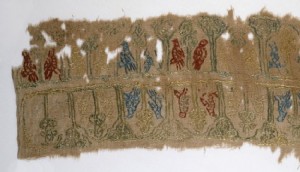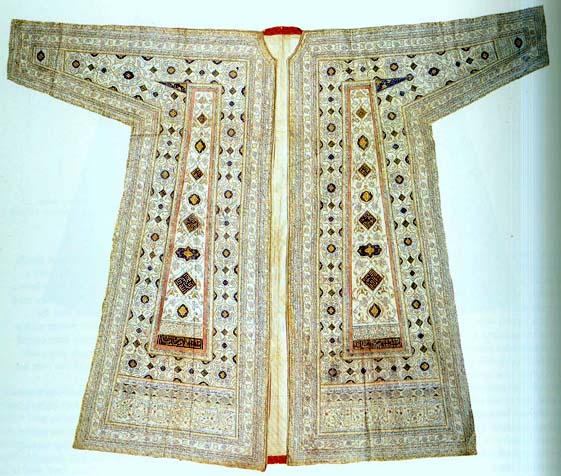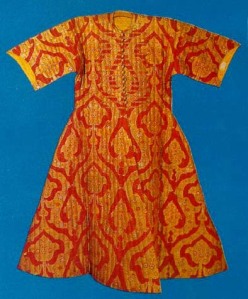The name Middle East is a misnomer, in that there is no one culture that covers the whole Middle East. I will put up links to the major empires and regions that I have found. If anyone finds anything that should be on the page, please let me know.
A Middle Eastern Clothing Primer, written by Woodrow Hill, is a good place to start from.
There are many museums that show their collections on-line. Some that contain Islamic art are The David Collection, The Textile Museum and the Ashmolean, which is linked to below. This is an Exhibition Catalogue Islamic Courtly Textiles & Trade Goods 14th-19th century, which is via Google Docs.
Arab Dress: a short history by Y. Stillman and N. Stillman is able to be read through Google Books. Preview only.
Islam in India and Pakistan by Annemarie Schimmel covers different cultural influences on garb and gives a glossary. Via Google Books, so preview only.
Women’s Costume of the Near and Middle East by Jennifer Scarce available through Google Books. Preview only.
Jews, Visigoths, and Muslims in medieval Spain: cooperation and conflict by Norman Roth covers a little of garb and the differences between Muslim, Jews and Christians in the Al-Andalus. Via Google Books.
This handout by Umm Hurayrah bint Khaalid (on Scribd) covers modern belly dance clothes, what not to wear and many pictures of period garb.
Costumes of the Levant by Margaret Clark Keatinge. An on-line book printed 1955.
The Art of Arabian Costumes by Heather Colyer Ross is available to read through Google books. Preview only.
There is a company in the U.S. called Reconstructing History which sell patterns for Medieval and Eastern Medieval clothing. Also for sale are the notes used to create the patterns.
This site is a small site on Period Gypsy Garb done by a SCAdian. A good place to start if interested. This site called 15th & 16th Century Gypsy Women’s Garb which has pictures and patterns.
The Mongols by Catriona Macpherson. Covers a little of the garb.
Ottoman Garb
This is from 1299-1923 AD, covering three continents at one stage. There are many books which cover the history of the Ottoman Empire but a digest is on Wikipedia. Many people know of the Ghawazee coat, but the Ghawazee were the lower class, street dancers who did not have the same clothes as the aristocracy. The Ghawazee coat known today, that goes under the bust, is an invention of the 1960s.
Here are articles I have found about female Turkish garb-
- Female Turkish Garb by Baroness Katja Davidova Orlova Khazarina.
- http://sca.berkeley.edu/garment_pattern/turkish_salwar.html
- http://www.scribd.com/doc/4865202/CompletePatternPublic-ppt-ReadOnly (this one also covers Persian garb)
- And this site has European descriptions of Ottoman Garb
- This site covers different textiles used on the kaftans in the Topkapi museum. Done by Explore Turkey.
- This site covers the Karakalpak people of the Autonomous Republic of Karakalpakstan. The site includes history, costumes and even yurts. The site has different pages for female costume and male costume.
Persian Garb
One of the oldest empires covering biblical times to 1921 AD. The Persians had many spats with the Byzantines and was invaded by Islamic conquerors in 644. The Mongols invaded Persia in 1218 and persisted until the 15th century. Check out the post Persian Garb for Duchess Roxane Farabi Shahzadeh’s patterns (pdfs to download).
- Here is an actual 14th century dress
- Here is an SCA website from Master Rashid in the East Kingdom
- Pre-Mongol Persian Garb, or Seljuk Turkish garb of the 11th & 12th century.
- Two pdf documents by Shelley Featherstone, aka Mistress Rosalynd of Thornabee on Tees about analysis of Persian patterns and Applications of the Persian Pattern Analysis.
Coptic (Ethiopian) and Early Egyptian Garb
Heavily influenced by the Roman Empire, it is quite hard to find many links to Coptic garb.

This is a link to an SCA blog by a lady named Greet. She has made a pdf document about Coptic embroidery.
Abbasid Silks of the Ninth Century by Ernst Kühnel. JStor article.
This is an article by the Bulletin of the Metropolitan Museum of Art about Coptic and Egypto-Arabic Textiles. Via Google Docs.
There is also a post covering Coptic children’s garb.
Here is a link to the Museum of Fine Arts, Boston. They have a picture up of a child’s Coptic tunic with embroidered ducks-
- http://www.mfa.org/collections/search_art.asp?recview=true&id=70038
- There are some actual tunics and pieces of embroidery to be found at The Victoria and Albert Museum.
- http://www.housebarra.com/EP/ep01/07coptic.html
- http://www.iub.edu/~iuam/online_modules/coptic/cophome.html
- http://jameelcentre.ashmolean.org/collection/8/per_page/50/offset/0/sort_by/date/object/6507
- This article, done by Sorcha Valdimarsdottir, covers Coptic embroidery.
Mamluk (late Egyptian)
This is from the 12th century until the 15th. After that, Egypt became part of the Ottoman Empire. Here is a digest version of the history.
This is a paper written by Jun-suk Kang, about the History of Textiles in Egypt.
The Ashmolean has many embroidery samples, with a wonderful zoom function. Please look!
Al-Andalus
The Arabs in Spain and Portugal came from the Maghreb or North African dynasties. Eventually they broke off from North Africa and became their own kingdom. Here is the wikipedia page.
- A page with period pictures of garb in Christian Spain from Mistress Maddalena Jessamyn di Piemonte.
Embroidery
- http://medieval.webcon.net.au/loc_middle_east_mamluk.html
- Some Egyptian “blackwork” by Heather Rose Jones, including a very good how to guide.
- http://home.comcast.net/~mathilde/embroidery/gallery/islgall.htm
- The Qantara site on Middle Eastern embroidery.
Other
The Renaissance Tailor covers making felt slippers. Follow through the other links on the site for boot, pants, coat and jewelry.
The page has instructions on how to make a Fez, head wear used by both sexes.
This page was written by Timothy Dawson, called Levantia: Stepping Out covers both male and female headwear, with a large bibliography.
An electronic book, Max Tilke: Oriental Costumes. Written in 1922 and transformed into an electronic book by Celestina Wroth & Jian Liu, for the Reference Department, Indiana University Libraries 1997.
Narah has written an article about Pre-17th century headwear.


Interesting to note there is a Turkish tradition of keeping the clothes of the head of the house when he passes away. This would explain why there are so many examples of male clothing Ottoman era, but very little of female, except for some princesses of the ruling sultans, in some instances.
I really enjoy the wealth of information that you have provided! May I suggest that there is an organisation devoted to researching and preserving the traditional dress of Oman, which is called
The Centre for Omani dress, directed by Julia AlZadjali, who co-curated an exhibition at the British Museum, in 2011(Adorment and identity, jewels and costume from Oman) and produced a book titled: The traditional Women’s Dress of Oman on the subject
Another good site for “Gypsy” clothing is that of Old Miriam who sadly passed away not too long ago:
http://www.buttery.org/marian/Gypsy_dress/drape_main.htm
For a basic overview of 16th c. Ottoman women’s clothing:
http://home.earthlink.net/~al-qurtubiyya/Otto_Fem_Cloth/ottofemcloth.html
And for a broader overview of Ottoman women’s clothing arranged by century so people can tell the 19th c. from the 16th, start at:
http://home.earthlink.net/~al-qurtubiyya/16/kultur-16.html
There are some pictures of men in there, too, but mostly women, since it is generally much harder to find pictures of women.
to any Muslims on this السلام عايكم to other مرحبا this is my first post I have read a number of posts that indicate that the turban is not worn generally in the period we are discussing, I disagree for two reasons first the turban according to the sunna ( a practice of the Prophet sws) he wore both a shorter one of unknown length Allah u alim but the turban he wore was around 9 ft by today’s measurements. Muslims especially in this time still stuck to the sunnah most of the period paintings i have seen indicate that both the kuffi that kind of a conical hat or like a fez being worn with a turban wrapped around it.
Can you please share which time period and region are you talking about? This page was to be a fairly simple reference to different clothing style over different regions and time periods, so I am happy to add to any information.
Hi Miriam, I love what you do. The links you provide are wonderful and the patterns you make, I hope to give a go to one day. Have you ever come across Ancient Egyptian garb online? And could you please point me in the right direction to direct my google searches?
Thanks, Stella.
Thanks Stella.
I haven’t researched Ancient Egyptian garb, as I mostly do medieval Egyptian garb (with occasional diversions into Ottoman and Persian). However there is a Facebook group called SCA Egypt that many members of do Ancient Egyptian garb. Good luck!
Thank you 🙂
is there any basis for large overall repeating patterns on the fabric of overdresses, or is this really just a SCAdianism?
Yes, there is. It depends on your time period & region though. Which one/s are you looking at?
Hi I have really enjoyed reading this post and the links you have shared are excellent – I am interested in Ottoman history, textiles and costume and am compiling my own research and development of women’s clothing and currently working on patterns to make the clothes. I have looked closely at two entaris that are in the V&A archive however I am not sure which century they belong – probably 18th C as they have long tight sleeves that are slit to the elbow. Would you agree that they might be 18thC? I can provide photographs. Also I would like to put a link to your site on my blog and include some of the reference links that you have on this page – if you don’t mind? My website is: http://www.mollywilliams.co.uk and blog: http://www.mollywilliams.blog that I have just started to archive my research and development notes. I would value your opinion. Many thanks, Molly
Hello Molly.
Which entaris in the V&A? Are they in the online collections?
Hi – I was able to study 2 entaris and several kaftan pieces at the Clothworkers Centre 2 years ago and will be posting my images and research notes on my blog http://www.mollywilliams.blog in the next few weeks. My latest blog on this study is:
https://mollywilliams.blog/2017/03/26/ottoman-kaftan-construction-linings/
I haven’t been able to find these entaris and kaftans on line today. The entaris I viewed were 19thC as per my notes and further research.
Will post more this week
Best wishes
Molly